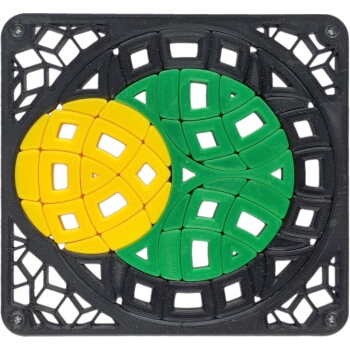|
Two intersecting circles with the larger circle split in one circle and a ring.
Epsilon Aurigae (ε Aurigae, abbreviated Epsilon Aur, ε Aur) is a multiple star system in the northern constellation of Auriga, the charioteer. It is an unusual eclipsing binary system comprising an F0 supergiant (officially named Almaaz /ælˈmɑːz/, the traditional name for the system) and a companion which is generally accepted to be a huge dark disk orbiting an unknown object, possibly a binary system of two small B-type stars. The distance to the system is still a subject of debate, but data from the Gaia spacecraft puts its distance at around 1,350±300 light years from Earth. Epsilon Aurigae was first suspected to be a variable star when German astronomer Johann Heinrich Fritsch observed it in 1821. Later observations by Eduard Heis and Friedrich Wilhelm Argelander reinforced Fritsch's initial suspicions and attracted attention to the star. Hans Ludendorff, however, was the first to study it in great detail. His work revealed that the system was an eclipsing binary variable, a star that dims when its partner obscures its light. About every 27 years, Epsilon Aurigae's brightness drops from an apparent visual magnitude of +2.92 to +3.83. This dimming lasts 640–730 days. In addition to this eclipse, the system also has a low amplitude pulsation with a non-consistent period of around 66 days. Epsilon Aurigae's eclipsing companion has been subject to much debate since the object does not emit as much light as is expected for an object its size. As of 2008, the most popularly accepted model for this companion object is a binary star system surrounded by a massive, opaque disk of dust; theories speculating that the object is a large, semitransparent star or a black hole have since been discarded. Nomenclature: Nature of the system: Variations on the high mass model have always been popular, since the primary star is to all appearances a large supergiant star. Spectroscopically it is early F or late A with luminosity class Ia or Iab. Distance estimates consistently lead to luminosities expected for a bright supergiant, although there is a huge variation in published values for the distance. The Hipparcos parallax measurement has a margin of error as large as the value itself and so the derived distance is likely to be anything from 355 to 4,167 parsecs. The low mass model, recently popularised by the Citizen Sky project, proposes that the primary is an evolved asymptotic giant branch star of 2–4 M☉. This relies on distance and luminosity estimates lower than most observations. The star would be an unusually large and bright giant star for the given mass, possibly as the result of very high mass loss. To match the observed eclipse and orbital data, the secondary is a fairly normal B main sequence star of about 6 M☉ embedded in a thick disc seen nearly edge on. The orbit itself is now fairly well determined, inclined at over 87 degrees to Earth. The primary and secondary are around 35 AU apart (in the high mass model), which is further than the planet Neptune from the Sun. In the low mass model, the separation is only 18 AU. Visible component: Eclipsing component: The disc around the secondary star is 3.8 AU wide, 0.475 AU thick, and blocks about 70% of the light passing through it, allowing some light from the primary star to be seen even during the eclipses. It radiates like a 550 K black body. Observation: Visual variable star observers make an estimate of its brightness by comparing its brightness with nearby stars with a known brightness value. This can be done by interpolating the brightness of the variable between two comparison stars, or by individually estimating the magnitude difference between the variable and several different comparisons. Repeating the observation on different nights allows a light curve to be produced showing the variation in brightness of the star. In practice, visual variable star estimates from many observers are statistically combined to produce more accurate results. The inventor designed it with hollow pieces and two sides with different colours. Contributors
No one has contributed to this page yet! Collections This puzzle can be found in collections of these members: lianium: Lianium's collection Found a mistake or something missing? Edit it yourself or contact the moderator. |
|





